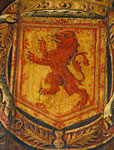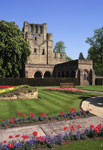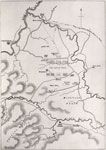|

 The Union of the Crowns is all the more remarkable as it brought together two previously warring nations in a peaceful way. The history of Scotland and England from the late 13th century to the 16th century is littered with battles and skirmishes, from the Wars of Independence fought with Edward I and II on the English side and William Wallace and Robert the Bruce on the Scottish side, the ill-advised campaign against Henry VIII by James IV leading to the disastrous (for the Scots) battle of Flodden, to the “Rough Wooing” series of military raids designed to force Scotland to accept Henry VIII's son Edward as the husband of James V's daughter Mary. While there remained an anxious enmity between the two countries, it remained largely subsumed as James VI gained the crown of England. The Union of the Crowns is all the more remarkable as it brought together two previously warring nations in a peaceful way. The history of Scotland and England from the late 13th century to the 16th century is littered with battles and skirmishes, from the Wars of Independence fought with Edward I and II on the English side and William Wallace and Robert the Bruce on the Scottish side, the ill-advised campaign against Henry VIII by James IV leading to the disastrous (for the Scots) battle of Flodden, to the “Rough Wooing” series of military raids designed to force Scotland to accept Henry VIII's son Edward as the husband of James V's daughter Mary. While there remained an anxious enmity between the two countries, it remained largely subsumed as James VI gained the crown of England.
Edward I Monument, Solway Firth
 King Edward I, "The Hammer of the Scots", died on the Solway in 1307 while attempting to again subject his troublesome northern neighbours to his iron will. The fords over the Solway in those days were quite different to today and it seems that there were crossings as far west as Bowness on Solway. King Edward I, "The Hammer of the Scots", died on the Solway in 1307 while attempting to again subject his troublesome northern neighbours to his iron will. The fords over the Solway in those days were quite different to today and it seems that there were crossings as far west as Bowness on Solway.
Edward's son continued this campaign against Scotland, however Edward II was not the same standard a military commander as his father. The Battle of Bannockburn, fought in 1314 between forces led by King Robert I (The Bruce) and Edward II saw the Scottish forces triumph and Bruce establish the independent Scotland, and his own kingship.
Kelso Abbey – “The Rough Wooing”
 The turbulent years in Anglo-Scottish relations between 1543 and 1549 have become known as the "Rough Wooing." In 1545 Henry VIII despatched the Earl of Hertford on a raid into the Borders to cause as much destruction as possible in an effort to subdue the Scots and subject them to his will. Hertford was instructed to fortify and garrison Kelso Abbey against the Scots but first he had to take it, for it was strongly held by a hundred men and twelve monks. However Hertford's cannon soon breached the walls, making an assault by Spanish mercenaries. The turbulent years in Anglo-Scottish relations between 1543 and 1549 have become known as the "Rough Wooing." In 1545 Henry VIII despatched the Earl of Hertford on a raid into the Borders to cause as much destruction as possible in an effort to subdue the Scots and subject them to his will. Hertford was instructed to fortify and garrison Kelso Abbey against the Scots but first he had to take it, for it was strongly held by a hundred men and twelve monks. However Hertford's cannon soon breached the walls, making an assault by Spanish mercenaries.
The Spaniards eventually took the Abbey, and the dwindling band of defenders was driven into the church tower where they were butchered to the last man. Hertford and his engineers however rejected the Abbey as a suitable fortress site in favour of the nearby ruins of Roxburgh Castle. Hertford had the lead stripped from the roof of Kelso Abbey and sent it in wagons to Wark Castle. Dryburgh, Melrose and Jedburgh Abbeys were also badly damaged during Hertford's destructive raid.
Battle of Flodden
 This 19th century engraving is an illustration of the Battle of Flodden, scene of one of the worst military disasters in Scotland's history. The field is near the village of Branxton in Northumberland in England. The English troops can be seen assembled just north of the Palisburn, while King James IV and his followers are to the south. This 19th century engraving is an illustration of the Battle of Flodden, scene of one of the worst military disasters in Scotland's history. The field is near the village of Branxton in Northumberland in England. The English troops can be seen assembled just north of the Palisburn, while King James IV and his followers are to the south.
On 9 September 1513 at Flodden Field, a 35,000-strong Scottish army was overwhelmed by an English force of around two-thirds the size. The thousands of Scottish dead included King James IV and much of the country's nobility. Much of the tragedy stems from the fact that Scotland under James IV was a relatively peaceful country, flourishing in the renaissance era.
|

















